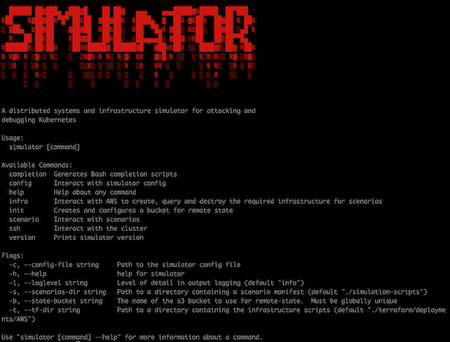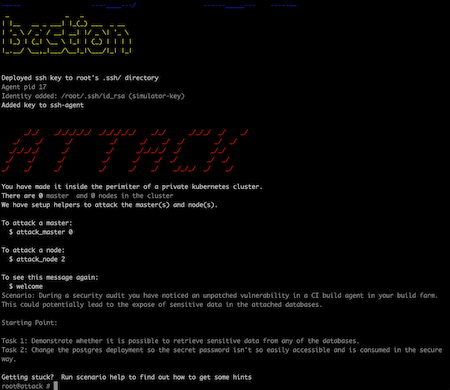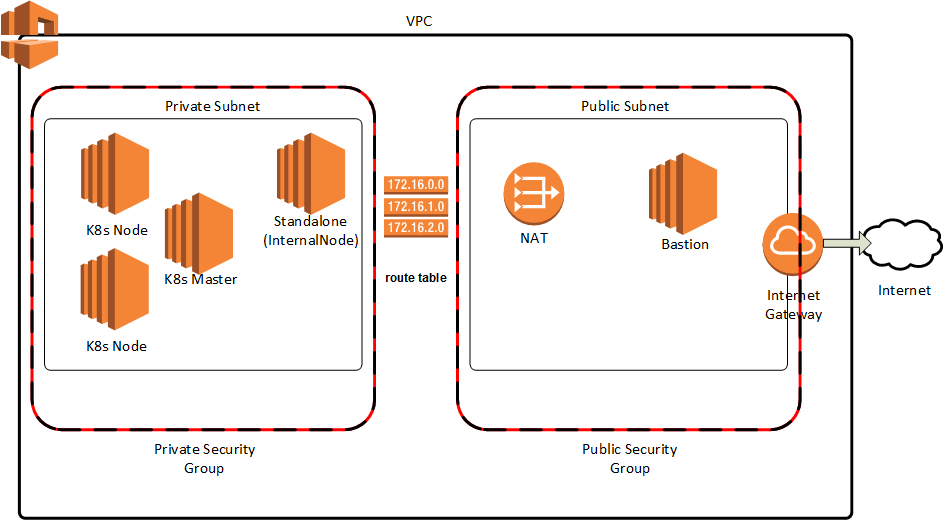A distributed systems and infrastructure simulator for attacking and debugging
Kubernetes: simulator creates a kuberntes cluster for you in your AWS
account; runs scenarios which misconfigure it and/or leave it vulnerable to
compromise and trains you in mitigating against these vulnerabilities.
For details on why we created this project and our ultimate goals take a look at the vision statement.
Ensure the AWS requirements are met and configured.
The quickest way to get up and running is to simply:
source <(curl https://raw.githubusercontent.com/kubernetes-simulator/simulator/master/kubesim)
or clone this repository and run:
make run
This will drop you into a bash shell in a launch container. You will have a
program on the PATH named simulator to interact with.
Refer to Simulator CLI Usage
Create a remote state bucket for terraform
simulator init
You will be asked for a name of a S3 bucket, which must be globally unique as pre AWS standards. If this does not exist it will be created, else the existing bucket will be used. This is used to store Terraform state to.
Create the infra if it isn't there
simulator infra create
This will standup the infrastructure, including an initial Kubernetes Cluster
List available scenarios
simulator scenario list
This will list all currently available scenrios
Launch a scenario (sets up your cluster)
simulator scenario launch node-shock-tactics
This will launch your selected scenario.
Login the environment
simulator ssh attack
Once you run simulator ssh attack you will be logged into a container running on the Bastion host. Upon login an outline of the challenge will be displayed. In addition, short cuts for logging into the master, or nodes, of the Kubernetes cluster are displayed. Use these shortcuts to log into the correct starting point as outlined in the challenge. Note that some starting points will require you are on the cluster first to access to starting point.
From within this container you have access to helper command start_task, next_hint and show_hints.
Start task
start_task 1
The start_task command is used to inform the simulator which task you are undertaking, and therefore what hints are available to aid you with that task.
Accessing hints
next_hint
The next_hint command will provide a hint to help you complete the task you have started with the start_task command.
Viewing all hints that have been requested
show_hints
The show_hints command will display all the hints you have requested to that point, in the task you have started.
Destroy your cluster when you are done
simulator infra destroy
Once you have finished you must destroy the environment to ensure that no additional costs are incurred. This command is actioned from within the launch container.
The following scenarios are available:
container-ambush
container-defeat-in-detail
container-phalanx-formation
etcd-inverted-wedge
master-bait-and-bleed
master-encirclement
network-feint
network-hammer-and-anvil
network-hedgehog-defence
network-swarming
node-amphibious-operations
node-raiding
node-shock-tactics
policy-echelon-formation
policy-fire-support
policy-force-dispersal
policy-vertical-envelopment
rbac-contact-drill
rbac-sangar
rbac-flanking-maneuver
rbac-shoot-and-scoot
secret-high-ground
secret-tank-desant
Simulator uses terraform to provision its infrastructure. Terraform in turn honours all the rules for configuring the AWS CLI. Please follow these.
You can provide your credentials via the AWS_ACCESS_KEY_ID and
AWS_SECRET_ACCESS_KEY, environment variables, representing your AWS Access Key
and AWS Secret Key, respectively. Note that setting your AWS credentials using
either these (or legacy) environment variables will override the use of
AWS_SHARED_CREDENTIALS_FILE and AWS_PROFILE. The AWS_DEFAULT_REGION and
AWS_SESSION_TOKEN environment variables are also used, if applicable.
https://www.terraform.io/docs/backends/types/s3.html
All the AWS_* configuration environment variables you have set will be propagated into the container
- If you get a timeout when running
simulator infra createafter about 10 minutes, the region you are using is probably running slowly. You must runsimulator infra destroyand then retrysimulator infra create AWS_REGIONvsAWS_DEFAULT_REGION- There have been some issues with the Go AWS client region configuration- Multi-account
Refer to the simulator terraform documentation
Simulator whether run in the launch container or on the host machine will generate its own SSH RSA key pair. It will configure the cluster to allow access only with this keypair and automates writing SSH config and keyscanning the bastion on your behalf using custom SSH config and known_hosts files. This keeps all simulator-related SSH config separate from any other configs you may have. All simulator-related SSH files are written to ~/.ssh and are files starting cp_simulator_
If you delete any of the files then simulator will recreate them and reconfigure the infrastructure as necessary on the next run
Refer to the scenario launch documentation
Refer to the Launch scenario flow documentation
Refer to the Tasks YAML file Format documentation
kubesim is a small script written in BASH for getting users up and running with simulator as fast as possible. It pulls the latest version of the simulator container and sets up some options for running the image. It can be installed with the following steps:
# cURL the script from GitHub curl -o kubesim https://raw.githubusercontent.com/kubernetes-simulator/simulator/master/kubesim # Make it executeable chmod a+x kubesim # Place the script on your path cp kubesim /usr/local/bin
To ensure all Git hooks are in place run the following
make setup-dev
Development targets are specified in the Makefile.
setup-dev Initialise simulation tree with git hooks devtools-deps: # Install devtools dependencies devtools Install devtools test-devtools: # Run all the unit tests for the devtools reset Clean up files left over by simulator validate-requirements Verify all requirements are met previous-tag: release-tag: gpg-preflight: run Run the simulator - the build stage of the container runs all the cli tests docker-build-no-cache Builds the launch container docker-build Builds the launch container docker-test Run the tests dep Install dependencies for other targets build Run golang build for the CLI program is-in-launch-container checks you are running in the launch container test run all tests except goss tests test-acceptance Run tcl acceptance tests for the CLI program test-smoke Run expect smoke test to check happy path works end-to-end test-unit Run golang unit tests for the CLI program test-cleanup cleans up automated test artefacts if e.g. you ctrl-c abort a test run test-coverage Run golang unit tests with coverage and opens a browser with the results docs Generate documentation release: gpg-preflight previous-tag release-tag docker-test docker-build build
We follow the conventional commit specification. Please ensure your commit messages adhere to this spec. If you submit a pull request without following them be aware we will squash and merge your work with a message that does.
- Simulator CLI tool - Runs in the launch container and orchestrates everything
- Launch container - Isolates the scripts from the host
- Terraform Scripts for infrastructure provisioning - AWS infra
- Perturb.sh - sets up a scenario on a cluster
- Scenarios
- Attack container - Runs on the bastion providing all the tools needed to attack a cluster in the given cloud provider
-
If you need to make changes to the format you should update this documentation.
-
Any changes should be accompanied by a bump of the version in the
kindproperty -
Use the
migrate-hintsdevtool to update the existing scenarios en-masse. You can make this tool available on your PATH by runningmake devtools
The simulator API docs are available on godoc.org:
Guidelines for contributors, and instructions on working with specific parts of Simulator are in the Contributor Guide.






